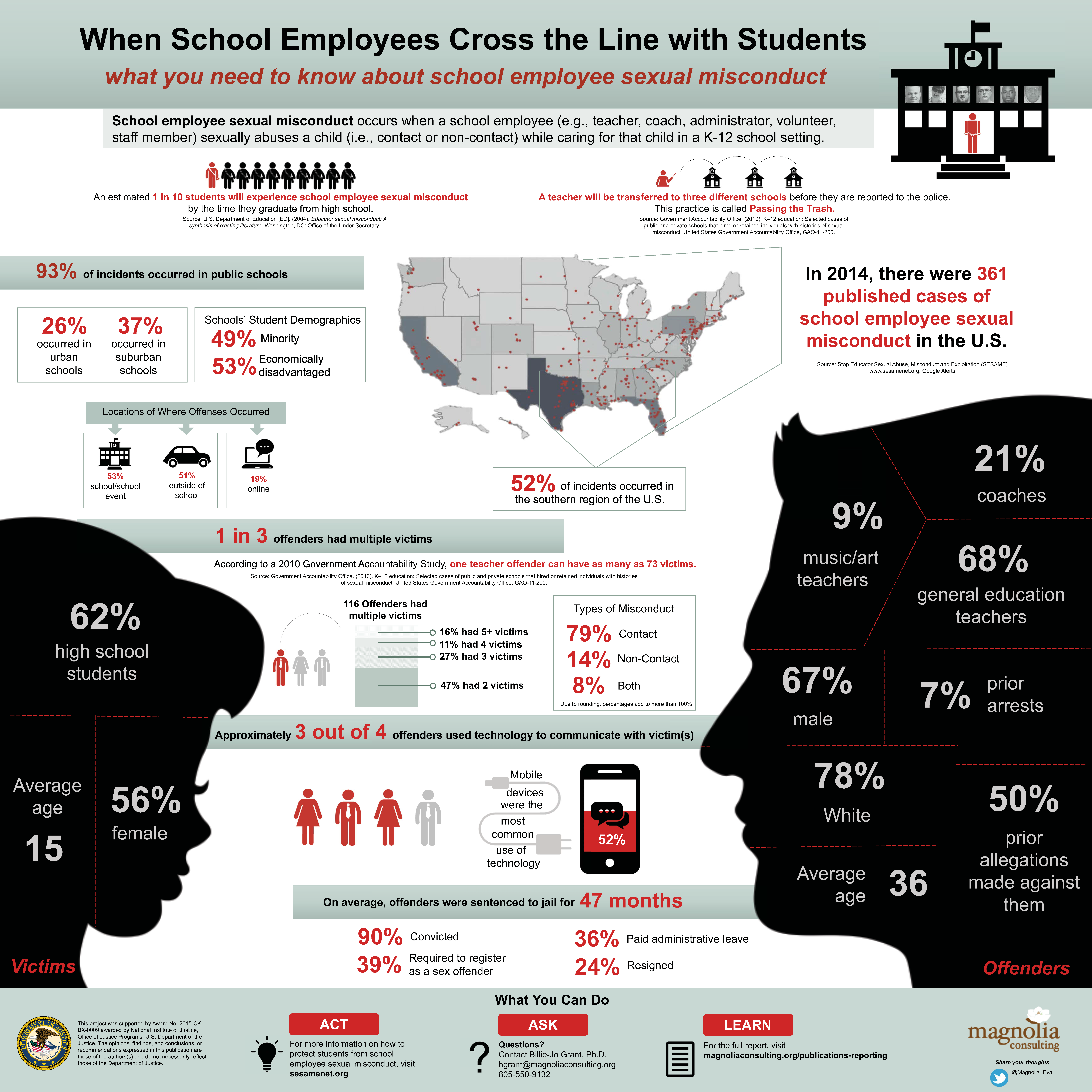From September 2016 to January 2017, Magnolia Consulting conducted a study on the implementation of Title IX guidance in school districts that had experienced incidents of school employee sexual misconduct in 2014. As part of the study, researchers conducted a landscape analysis of 459 cases from 2014 originally archived by Stop Educator Sexual Abuse Misconduct and Exploitation (S.E.S.A.M.E.), a nonprofit organization dedicated to preventing school employee sexual misconduct, using Google alerts to capture mentions in online media. The analysis sought to identify key characteristics of the schools where cases occurred as well as of offenders and victims. The information presented in this blog post is based on that database.
School employee sexual misconduct refers to sexual abuse (inappropriate or illegal contact) or misconduct (inappropriate communication or other unethical behaviors that may not involve physical contact) by a school employee (a teacher, coach, administrator, volunteer, or other staff member) with a child while caring for that child in a K–12 school setting. As the frequency of media headlines around this topic demonstrates, school employee sexual misconduct is far from uncommon in the United States. While prevalence data are not readily available, data from the year 2000 suggest that approximately one in 10 students will experience sexual abuse or misconduct at the hands of a school employee, ranging from sexual jokes to sexual intercourse, by the time they graduate from high school (American Association of University Women, 2001).
Who are the offenders and victims in school employee sexual misconduct cases?
In an effort to better understand offenders and victims, we analyzed demographic data from cases reported by the media in 2014. There are several limitations to using media reports in this way. Most notably, these cases represent only the tip of the iceberg; many more incidents go unreported to law enforcement and therefore are not publicly reported. Further, no two offenders or victims are the same. However, our sample provides a glimpse into who is typically involved. Additionally, we were able to gather information about the characteristics of schools where school employee sexual misconduct occurred.
Offender characteristics
In our sample, offenders were mostly general education teachers, male, white, and heterosexual, with an average age of 36. Half of the offenders had been the subject of previous allegations of inappropriate relationships with students. Approximately 3 out of 4 offenders used technology to communicate with victims, with mobile devices being the most common form of technology used. A third of offenders had more than one victim; almost half of offenders who had multiple victims (47%) had two victims.
Victim Characteristics
While media reports tended to protect information about victims, victim age and gender were typically reported in the cases we analyzed. Thus, we know that victims of school employee sexual misconduct were most often female and teenagers. Slightly over half of victims in our sample were female (56%), with an average age of 15.
What are the characteristics of schools where school employee sexual misconduct occurs?
In our sample, schools that experienced incidents of school employee sexual misconduct were most often located in the southern region of the United States. We found that incidents were more frequently reported in public, suburban high schools. Additionally, cases were more common in schools with high percentages of minorities and students eligible for free and reduced-price lunch. Slightly over half (53%) of incidents in our sample occurred off school premises.
Although we were able to glean much information about school employee sexual misconduct from media cases reported in 2014, more reliable reporting about school employee sexual misconduct is needed to better understand who is being affected and to improve tracking of offenders. If you are interested in learning more about our study, please find the full report here. Along with the report, we created an infographic detailing more information about characteristics. Additionally, visit S.E.S.A.M.E.’s website for additional resources and information about school employee sexual misconduct.
References
American Association of University Women [AAUW] (2001). Hostile hallways: The AAUW survey on sexual harassment in America’s schools. Washington, DC: American Association of University Women.

